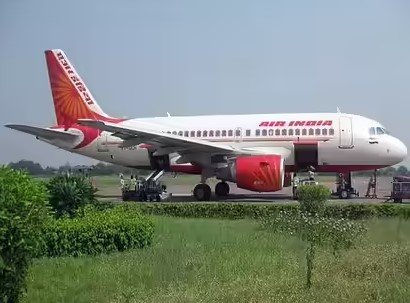A late-night Air India flight from Riyadh to Delhi found itself rerouted hundreds of kilometers away as dense monsoon clouds rolled into the capital and grounded arrivals.
Flight AI926, which left Riyadh on Sunday evening, was meant to reach Delhi by 1 a.m. Monday. But instead of touching down at Indira Gandhi International Airport, the aircraft veered off course and landed in Jaipur, a detour forced by poor visibility and weather disruptions in the capital region.
Passengers Land in Jaipur—And Then Hit the Road
The weather in Delhi wasn’t playing nice. Sources familiar with the situation said visibility at IGI Airport dropped below safe landing levels just before midnight.
As a result, AI926, carrying a full load of passengers from Saudi Arabia, was re-routed mid-air and landed at Jaipur International Airport instead.
What happened next wasn’t exactly a textbook response.
Despite Air India offering an alternative flight from Jaipur to Delhi, several passengers simply opted out. Many of them—tired, perhaps frustrated—chose to complete the journey by road instead, a roughly 5-hour ride across state lines. They hired taxis and private cars, determined to sleep in their own beds.
One passenger said, “We were already tired after the long haul. Waiting again for another flight didn’t make sense. Jaipur to Delhi by road was quicker and honestly, easier.”

Growing Concerns Over Weather-Linked Disruptions
This is not a one-off event. The Indian monsoon, which arrived later than expected this year, has been creating a storm of disruptions across North India. Air traffic is among the worst hit.
In fact, the AI926 incident came just days after another Air India flight—AI357 from Tokyo to Delhi—had to be diverted to Kolkata. That time, the problem wasn’t the weather but a persistent cabin temperature issue caused by a faulty air conditioning system.
Still, the pattern is clear: passengers are increasingly being left stranded, rerouted, or forced into long, unplanned delays.
Aviation expert Kapil Kaul from CAPA India said, “We are entering a period where Indian aviation needs stronger contingency planning. Whether it’s monsoon fog or technical snags, passengers deserve better.”
Not the First, Won’t Be the Last
The monsoon season, while essential for India’s agriculture and groundwater recharge, routinely knocks the wind out of airline schedules. This year has been particularly harsh due to a combination of late onset, intense showers, and electrical storms over northern India.
Let’s take a look at recent major disruptions that have impacted key air routes:
| Flight Route | Airline | Disruption Type | Alternative Route / Action Taken |
|---|---|---|---|
| Tokyo–Delhi | Air India | Cabin AC malfunction | Diverted to Kolkata |
| Riyadh–Delhi | Air India | Bad weather in Delhi | Diverted to Jaipur; road travel used |
| Dubai–Amritsar | IndiGo | Low visibility | Diverted to Chandigarh |
| Mumbai–Delhi | Vistara | Thunderstorm delay | 3-hour tarmac wait before takeoff |
These are just examples from the last three weeks alone.
Is Communication Falling Short?
There’s also a growing undercurrent of dissatisfaction around how these disruptions are handled, especially communication on the ground.
Some passengers on AI926 told reporters that updates were sparse. “We were left guessing for about 45 minutes after landing in Jaipur,” one traveler said. “Nobody told us what was next until someone finally said there’s another flight, or we can take the road. That’s not how it should work.”
Even more frustrating for some was the fact that bags were reportedly delayed for nearly an hour.
To make matters trickier, Jaipur Airport doesn’t always have the capacity to process large volumes of international arrivals—especially when they land outside of scheduled time slots.
What Happens to International Arrivals When Diverted?
This part’s a bit messy.
When international flights get diverted within India, the passengers must technically be processed through immigration and customs again. In the case of AI926, sources say the passengers were still processed as domestic transfers because they never officially entered the country via Delhi.
That procedural loophole raises concerns about preparedness.
Here’s what usually happens:
-
International passengers land at alternate airports with no international processing capacity.
-
Airline staff coordinate with local authorities to arrange temporary clearance or special handling.
-
Passengers are sometimes re-routed on connecting flights or allowed to exit via domestic terminals, depending on diplomatic permissions.
It’s not exactly a smooth system.
Behind the Scenes: Why Jaipur?
Why not Lucknow? Or Chandigarh?
According to Air Traffic Control sources, Jaipur has increasingly become a preferred alternate landing site for Delhi-bound flights during disruptions. The airport has decent capacity, it’s relatively close to Delhi by Indian standards, and it doesn’t get too foggy in the monsoon months.
But it’s not without problems. At 1 a.m., when AI926 landed, there were limited ground staff, no dedicated Air India support desk, and sparse cab availability.
So while it looks good on a flight operations chart, for real passengers, it’s less than ideal.
Bigger Picture: Weather Is Just One Piece of the Puzzle
Yes, monsoon weather is hard to predict and harder to control. But what really stands out is the need for better coordination between the Directorate General of Civil Aviation (DGCA), airlines, and local airport authorities.
This month alone, there have been over 30 diversions at IGI Airport, according to data sourced from Flightradar24 and airline dispatches. Most passengers are informed only mid-air or after landing.
Experts are now calling for a centralized digital alert system so flyers get real-time updates about possible delays, diversions, or alternative travel options.
Air India, for its part, said in a short statement that “passenger safety remains our top priority” and “all due assistance was provided.”
Well, sure. But for those on AI926 who ended up watching sunrise over a bumpy highway from Jaipur to Delhi, it might not have felt that way.
